Don’t let the retro look of the mechanical men built by Swiss artisan Francois Junod deceive you — they fascinate tech fans from Silicon Valley to Asia and will no doubt gain broader popularity after the launch of Martin Scorsese’s film Hugo about a secret hidden in an automaton.
The latest of Junod’s time-consuming projects is an 80cm wind-up Leonardo da Vinci figure that will be able to do intricate drawings and write mirror-inverted texts in Latin.
“I have been working on the sculpture for 10 years and on the mechanism for six years. I do not have a buyer yet so I can take my time,” Junod said, surrounded by a mishmash of tools, machines and sketches in his workshop in the village of Sainte-Croix perched high up in the Swiss Jura mountains.
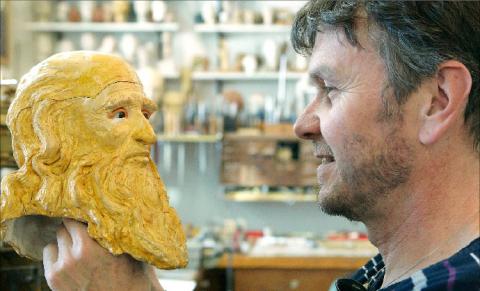
Photo: Reuters
His most complicated creation so far, an Alexander Pushkin animated by a complex mechanism enabling it to write down 1,458 different poems, was bought last year by a Silicon Valley entrepreneur for a price kept secret.
“Complex models can take years of work and cost up to 1.2 million Swiss francs [US$1.32 million],” Junod said, proudly showing historical automata that collectors from around the world ask him to restore.
“Before, I mainly worked for Japanese clients because automata really have a tradition there, but today, I have customers from all around the world,” said Junod, who counts the Sultan of Brunei and the late Michael Jackson among his clients.
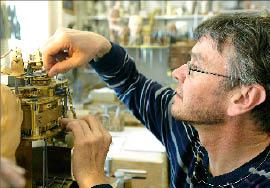
Photo: Reuters
Interest in these sophisticated dolls, known as automata, is likely to get a fresh boost from Scorsese’s new 3D film Hugo.
Based on a best-selling children’s book by Brian Selznick, the film tells the tale of a young boy in a Paris railway station in the 1930s who struggles to uncover a secret hidden in his father’s automaton.
“The film is going to be a good advertisement for my business,” Junod said. “People who watch it may think nobody makes automata anymore.”
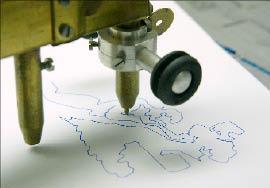
Photo: Reuters
Good-humored, enthusiastic Junod, who went through some rough times when he started making the self-operating machines in 1984, is one of the last craftsmen specialized in an art serving no other purpose than to surprise with its complexity.
“That’s what makes automata different from robots, which normally have a practical purpose. They are poetic,” he said.
Junod wants to give his Leonardo da Vinci a transparent back to make the mechanism visible.
“It’s part of the fascination with automata that people can understand how they work. These days, ever more objects are beyond our comprehension,” he said.
Junod’s automata are animated by a complex wind-up mechanism, not unlike the one in a mechanical watch, allowing them to accomplish a precise programmed series of gestures, which has often triggered comparisons with our modern computers.
The roots of these surprising machines reach back to ancient Greece, but they had their heyday in the 18th century when a general fascination with artificial humans helped watch and automaton maker Pierre Jaquet-Droz’s work win the favors of French King Louis XVI and his wife, Marie-Antoinette.
Jaquet-Droz’s three masterpieces — The Musician, The Writer and The Draughtsman — are on display in a Neuchatel museum and will be part of a large automata exhibition next year.
Junod has made several automata for high-end watch brand Jaquet Droz, now owned by Swatch Group, which wants to revive this heritage and a closer partnership is in the works.
“The idea is that I develop prototypes that Jaquet Droz then produces in small numbers,” he said.
“That is what I love: developing new machines, rather than reproducing,” he said, remembering how he once declined late Swatch Group founder Nicolas Hayek’s offer to work exclusively for the world’s largest watchmaker.

RECYCLE: Taiwan would aid manufacturers in refining rare earths from discarded appliances, which would fit the nation’s circular economy goals, minister Kung said Taiwan would work with the US and Japan on a proposed cooperation initiative in response to Beijing’s newly announced rare earth export curbs, Minister of Economic Affairs Kung Ming-hsin (龔明鑫) said yesterday. China last week announced new restrictions requiring companies to obtain export licenses if their products contain more than 0.1 percent of Chinese-origin rare earths by value. US Secretary of the Treasury Scott Bessent on Wednesday responded by saying that Beijing was “unreliable” in its rare earths exports, adding that the US would “neither be commanded, nor controlled” by China, several media outlets reported. Japanese Minister of Finance Katsunobu Kato yesterday also
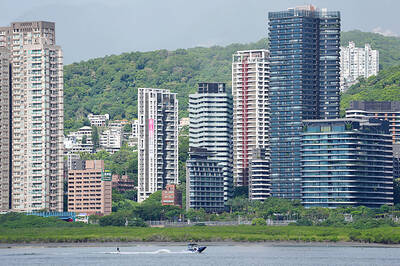
Taiwan’s rapidly aging population is fueling a sharp increase in homes occupied solely by elderly people, a trend that is reshaping the nation’s housing market and social fabric, real-estate brokers said yesterday. About 850,000 residences were occupied by elderly people in the first quarter, including 655,000 that housed only one resident, the Ministry of the Interior said. The figures have nearly doubled from a decade earlier, Great Home Realty Co (大家房屋) said, as people aged 65 and older now make up 20.8 percent of the population. “The so-called silver tsunami represents more than just a demographic shift — it could fundamentally redefine the
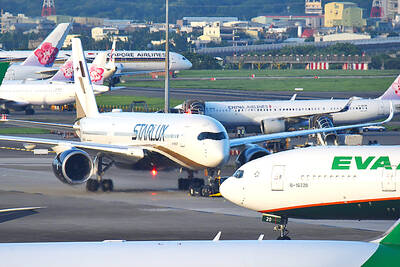
China Airlines Ltd (CAL, 中華航空) said it expects peak season effects in the fourth quarter to continue to boost demand for passenger flights and cargo services, after reporting its second-highest-ever September sales on Monday. The carrier said it posted NT$15.88 billion (US$517 million) in consolidated sales last month, trailing only September last year’s NT$16.01 billion. Last month, CAL generated NT$8.77 billion from its passenger flights and NT$5.37 billion from cargo services, it said. In the first nine months of this year, the carrier posted NT$154.93 billion in cumulative sales, up 2.62 percent from a year earlier, marking the second-highest level for the January-September

‘DRAMATIC AND POSITIVE’: AI growth would be better than it previously forecast and would stay robust even if the Chinese market became inaccessible for customers, it said Taiwan Semiconductor Manufacturing Co (TSMC, 台積電) yesterday raised its full-year revenue growth outlook after posting record profit for last quarter, despite growing market concern about an artificial intelligence (AI) bubble. The company said it expects revenue to expand about 35 percent year-on-year, driven mainly by faster-than-expected demand for leading-edge chips for AI applications. The world’s biggest contract chipmaker in July projected that revenue this year would expand about 30 percent in US dollar terms. The company also slightly hiked its capital expenditure for this year to US$40 billion to US$42 billion, compared with US$38 billion to US$42 billion it set previously. “AI demand actually